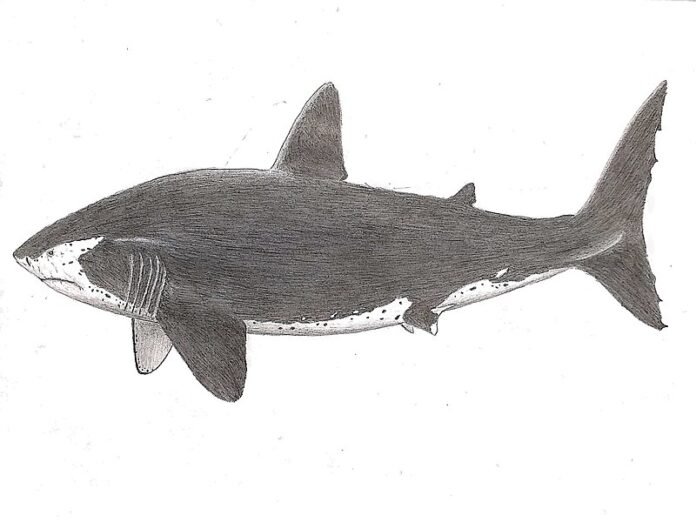Extinct gigantic megatooth sharks were at the top of the marine food web once. Their evolution to gigantic sizes and their extinction are not well understood. A recent study analysed isotopes from the fossil teeth and found that these sharks developed endothermic thermoregulation and evolved to gigantic sizes but the high metabolic costs and bioenergetic demands could not be sustained longer following shrinkage of productive habitats due to climate change and sea level changes. Consequently, they became extinct 3.6 million years ago. This study also brings to fore the fact that like the extinct megatooth sharks, the modern shark species too are not immune to the effects of climate change hence the need for their conservation.
Megatooth Sharks, meaning “big tooth” sharks, were supersized gigantic sharks that evolved in the Cenozoic era, acquired body size of about 15m and became extinct about 3.6 million years ago (Mya) during the Pliocene epoch.

Theses giant sharks were endowed with sharp, banana-size teeth and were one of the largest in body size (next only to blue whale). They are considered to be one of most powerful marine predators to have ever lived which preyed on whales, dolphins, seals, and other smaller sharks.

During its evolution, these sharks had undergone drastic changes in dentition including widened crowns and serrated cutting edges which enabled them to shift from fish-based diet to more energetic marine mammals-based diet. This helped them achieve much richer nutrition which was one of reasons behind their evolution to gigantic body sizes1.
Megatooth sharks were at the top of the food web and ultimate predator2. They had a higher trophic level for any marine species. (Trophic level is the position of an organism in the food chain, it ranges from a value of 1 for primary producers to 5 for marine mammals and humans).
How these sharks evolved to gigantic body sizes and why they became extinct about 3.6 million years ago?
| Ectothermy | Cold-blooded, includes all animals except birds and mammals. e.g., sharks |
| Mesothermy (or, regional endothermy) | Animal with a thermoregulatory strategy intermediate to cold-blooded ectotherms and warm-blooded endotherms. e.g., some sharks, sea turtle |
| Endothermy | Warm-blooded animals, maintain a constant body temperature irrespective of the ambient temperature, includes birds and mammals. (Endothermy include regional endothermy or mesothermy in the broad sense) |
Sharks are cartilaginous fishes and are cold-blooded marine animals (ectothermic). Such animals have no ability to metabolically elevate body temperature and retain heat.
Had megatooth sharks undergone thermo-physiological changes in course of its evolution to acquire endothermic properties? This hypothesis is relevant because unlike cold-blooded (ectothermic), warm-blooded (endothermic) marine animals can have higher cruising speeds and can travel longer distances to catch preys than ectothermic counterparts. Acquisition of endothermic properties (along with transformed dentition) could explain why these sharks evolved to such gigantic sizes.
In a recent study published in PNAS on 26th June 2023, researchers investigated thermo-physiology of megatooth sharks to explain its evolution and extinction. They studied geochemical evidence for thermoregulation from clumped isotope paleothermometry and phosphate oxygen isotopes obtained from fossil tooth samples and found that isotope-inferred body temperatures of Otodus species averaged about 7 °C higher than ambient seawater temperatures and other coexisting shark species. An overall warmer body temperature means megatooth sharks had evolved to be endothermic suggesting endothermy was a key driver for their gigantism3. But this thermoregulatory ability proved costly for megatooth sharks in due course.
Megatooth sharks were apex predator at the top of marine food web2. Their top trophic level diet, gigantic body sizes and endothermic physiology meant high metabolic costs and high bioenergetic demands. The energy balance was disturbed when productive habitats diminished, and sea level changed. This altered prey landscape, and prey become scarce. The consequent food shortage put negative selection pressure against gigantic megatooth sharks culminating in their extinction 3.6 Mya. Endothermy, the key driver in the evolution of megatooth sharks also contributed to their extinction following changes in climate.
Like the extinct megatooth sharks, the modern shark species are not immune to the effects of climate change hence the need for their conservation.
***
References:
- Ballell, A., Ferrón, H.G. Biomechanical insights into the dentition of megatooth sharks (Lamniformes: Otodontidae). Sci Rep 11, 1232 (2021). https://doi.org/10.1038/s41598-020-80323-z
- Kast E.R. et al 2022. Cenozoic megatooth sharks occupied extremely high trophic positions. Science Advances. 22 Jun 2022. Vol 8, Issue 25. DOI: https://doi.org/10.1126/sciadv.abl6529
- Griffiths M.L., et al 2023. Endothermic physiology of extinct megatooth sharks. PNAS. June 26, 2023. 120 (27) e2218153120. https://doi.org/10.1073/pnas.2218153120
***






































